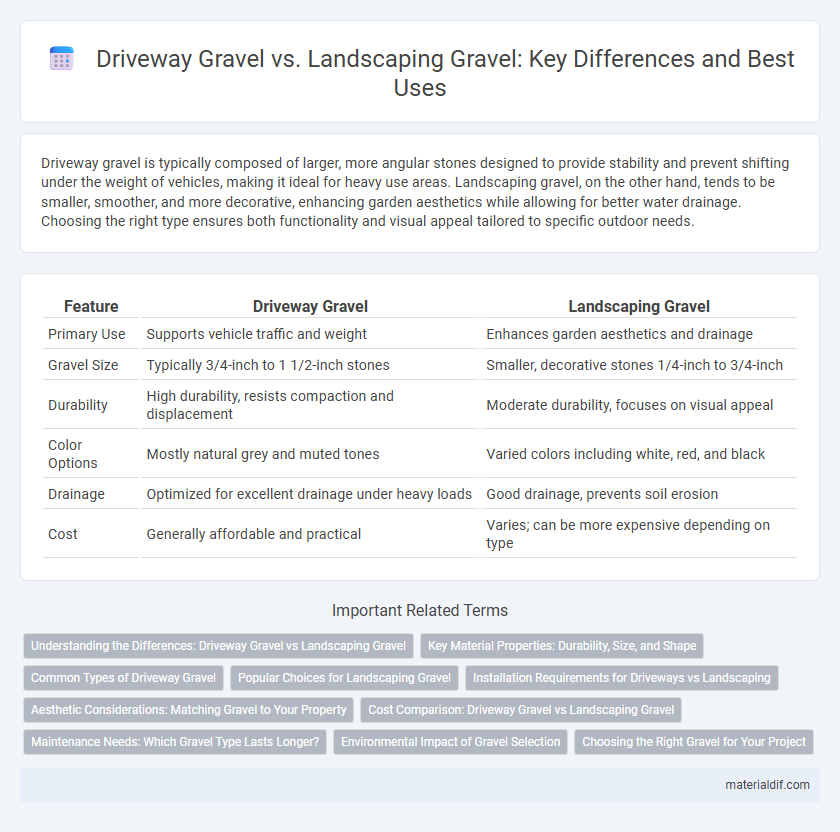Driveway gravel is typically composed of larger, more angular stones designed to provide stability and prevent shifting under the weight of vehicles, making it ideal for heavy use areas. Landscaping gravel, on the other hand, tends to be smaller, smoother, and more decorative, enhancing garden aesthetics while allowing for better water drainage. Choosing the right type ensures both functionality and visual appeal tailored to specific outdoor needs.
Table of Comparison
| Feature | Driveway Gravel | Landscaping Gravel |
|---|---|---|
| Primary Use | Supports vehicle traffic and weight | Enhances garden aesthetics and drainage |
| Gravel Size | Typically 3/4-inch to 1 1/2-inch stones | Smaller, decorative stones 1/4-inch to 3/4-inch |
| Durability | High durability, resists compaction and displacement | Moderate durability, focuses on visual appeal |
| Color Options | Mostly natural grey and muted tones | Varied colors including white, red, and black |
| Drainage | Optimized for excellent drainage under heavy loads | Good drainage, prevents soil erosion |
| Cost | Generally affordable and practical | Varies; can be more expensive depending on type |
Understanding the Differences: Driveway Gravel vs Landscaping Gravel
Driveway gravel typically consists of larger, more durable stones like crushed granite or limestone, designed to withstand heavy traffic and provide stability for vehicles. Landscaping gravel is often smaller, smoother, and aesthetically focused, available in various colors to enhance garden beds, pathways, and decorative features. Understanding these differences ensures the appropriate gravel type is selected for either functional durability or visual appeal.
Key Material Properties: Durability, Size, and Shape
Driveway gravel typically features larger, more angular stones that provide excellent durability and interlock to support heavy vehicle loads, reducing shifting and compaction. Landscaping gravel often consists of smaller, rounded stones designed for aesthetic appeal and effective drainage in garden beds or pathways. The differences in size and shape between driveway and landscaping gravel directly influence their suitability--driveway gravel prioritizes strength and stability, while landscaping gravel focuses on texture and water permeability.
Common Types of Driveway Gravel
Common types of driveway gravel include crushed stone, pea gravel, and granite gravel, each offering unique durability and drainage properties suitable for supporting vehicle weight. Crushed stone provides a stable base with angular edges that lock together, enhancing traction and reducing shifting. Pea gravel, valued for its smooth texture and aesthetic appeal, is less stable but ideal for light traffic, while granite gravel combines strength and weather resistance, making it a popular choice for long-lasting driveways.
Popular Choices for Landscaping Gravel
Popular choices for landscaping gravel include pea gravel, river rock, and decomposed granite, prized for their aesthetic appeal and functional properties. Pea gravel is favored for its smooth texture and versatility in pathways and garden beds, while river rock offers a natural look with larger, rounded stones ideal for drainage. Decomposed granite provides a compact surface suitable for walkways and patios, blending seamlessly with garden designs and supporting plant health through improved soil drainage.
Installation Requirements for Driveways vs Landscaping
Driveway gravel requires a thicker base layer, typically 6 to 12 inches of crushed stone, to support heavy vehicle traffic and prevent shifting or rutting. Landscaping gravel installation often involves a thinner base, around 2 to 4 inches, primarily for decorative purposes and improved drainage. Proper grading and compacting are essential for both, but driveway gravel demands more robust sub-base preparation to ensure durability and stability under load.
Aesthetic Considerations: Matching Gravel to Your Property
Driveway gravel typically consists of larger, more angular stones designed to provide durability and traction, often in neutral tones like gray or tan that complement asphalt or concrete surfaces. Landscaping gravel offers a broader color palette, including reds, whites, and blues, allowing for creative aesthetic matching with garden beds, walkways, or decorative features. Choosing gravel that harmonizes with your property's architectural style, plant selections, and overall color scheme enhances curb appeal and creates a cohesive outdoor environment.
Cost Comparison: Driveway Gravel vs Landscaping Gravel
Driveway gravel typically costs between $0.30 to $1.50 per square foot, depending on factors such as gravel type and thickness, while landscaping gravel ranges from $0.20 to $2.00 per square foot based on decorative quality and color options. Driveway gravel is usually more robust and requires thicker layers, increasing overall expense compared to finer, aesthetic-focused landscaping gravel. Labor and delivery fees may also vary, impacting the total cost difference between driveway and landscaping gravel installations.
Maintenance Needs: Which Gravel Type Lasts Longer?
Driveway gravel typically consists of larger, crushed stones designed to withstand heavy vehicle traffic and resist displacement, requiring occasional replenishment and grading to maintain a stable surface. Landscaping gravel is generally finer and decorative, prone to being washed away or scattered by weather and foot traffic, necessitating more frequent top-ups and weed control. Due to its durability and compaction, driveway gravel usually lasts longer with less maintenance compared to landscaping gravel.
Environmental Impact of Gravel Selection
Driveway gravel typically consists of crushed stone or pea gravel, which enhances drainage and reduces runoff, positively impacting local water quality. Landscaping gravel often includes decorative varieties like river rock or decomposed granite that can influence soil temperature and moisture retention, affecting plant health and local microbes. Choosing gravel with natural, locally sourced materials minimizes carbon footprint and supports sustainable environmental management practices.
Choosing the Right Gravel for Your Project
Driveway gravel typically consists of crushed stone that compacts well to provide a stable, durable surface capable of supporting vehicle weight, making it ideal for high-traffic areas. Landscaping gravel, on the other hand, often includes smoother, decorative stones such as pea gravel or river rock, chosen primarily for aesthetic appeal and drainage in garden beds or pathways. Selecting the right gravel depends on evaluating factors like load-bearing requirements, drainage needs, and desired visual effect to ensure functionality and longevity in your project.
Driveway Gravel vs Landscaping Gravel Infographic

 materialdif.com
materialdif.com